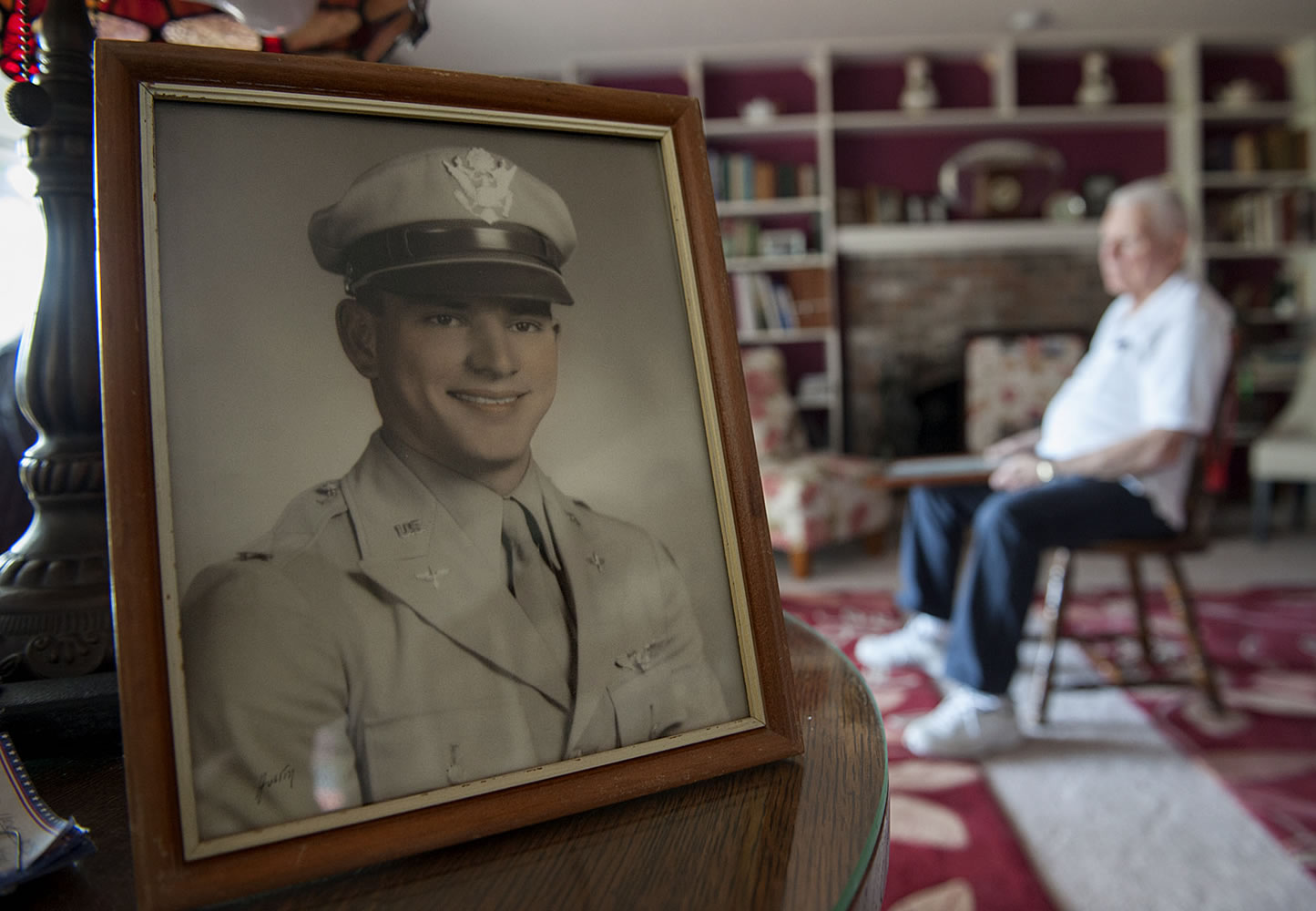Larry Stewart still refers to the place as his office.
Workplace hazards included German fighter pilots, fog-bound runways and bursts of flak from anti-aircraft artillery.
There were other hazards — including trees and church steeples — and any of them would result in a very bad day at the office.
Stewart was a navigator in a B-24 Liberator bomber during World War II. He was part of the U.S. Army’s 8th Air Force, 467th Bomb Group, 789th Bomb Squadron.
Stewart flew 31 missions over Europe in 1944 and 1945 as the Allied bombing campaign destroyed Germany’s capacity to wage war.
Explaining his role, the Vancouver veteran picked up a photograph of a Liberator. He pointed to a spot between the cockpit and the nose machine-gun turret. There was a small window on the side of the nose section: the location of what Stewart called his office.
“The nose gunner climbed past me to get in,” Stewart said recently in the Fairway Village home he shares with Rita, his wife of 64 years.
As navigator, Stewart wasn’t tasked with getting “Gremlin Manor” to the target; it was his job to get the plane back. The 8th Air Force launched 36 Liberators in a bomb group, which would follow a lead aircraft to a German industrial center or transportation hub. Then they’d all fly back together … if things went according to plan. Things never did.
“Two or three would get separated,” Stewart said. Some B-24s would be damaged, and if there was quite a bit of flak, he said, the pilot would be forced to choose a safer heading.
On one mission, Stewart recalled, “The pilot told me we couldn’t keep up” with the rest of the formation. The pilot’s punch line was: “Where are we?”
That sort of challenge seemed to appeal to Stewart, who went on to become an electrical engineering professor after the war. Stewart, who grew up in Pasadena, Calif., already was studying math and physics in junior college when he enlisted in the Army in June 1943.
“If I got drafted, I’d run into Germans on the ground,” he reasoned. “I volunteered for the Air Force, and navigator was the only job with any math to it.”
After completing training, Stewart became a second lieutenant at age 19. He and his crew mates flew from an airbase in Rackheath, England. Their first mission was on Dec. 2, 1944; the 31st and final mission was on April 25, 1945.
The B-24s were designed to carry a 10-man crew, including four officers — pilot, co-pilot, navigator and bombardier. Six enlisted men served as engineer and radioman and manned the plane’s .50-caliber machine guns.
Most crews didn’t need a bombardier to zero in on the target, however, and releasing the bomb load often was Stewart’s job.
“Only the first one or two planes in a squadron had bombardiers,” Stewart said. “When the lead planes dropped theirs, we dropped ours.”
The B-24s could fly farther and faster than the legendary B-17 Flying Fortresses, and the Liberators carried a bigger payload. They flew lower over their targets, however, down to about 18,000 feet or so. That made the B-24s more vulnerable to enemy flak, but the Liberators had better accuracy when they dropped their bombs.
And they definitely flew lower than that. Their next-to-last mission was a scary one. Heading home under low clouds, they steered around church steeples in Germany and France.
Once, Stewart said, “We were almost at treetop level.”
The 90-year-old Stewart told his story in a 1998 memoir, “The Forbidden Diary: A B-24 Navigator Remembers.” Airmen weren’t supposed to write journals, he said, but Stewart kept a diary in a notebook.
After the war, Stewart returned to Pasadena Junior College. He earned his bachelor’s and master’s degrees in electrical engineering at Stanford. He taught at the University of Michigan and the University of Arizona, and also wrote several textbooks.
Larry and Rita also raised a family, which puts an interesting perspective on the experiences he described in his WWII memoir.
“My grandson will be 21 in January,” Rita said, and to her, “He’s a baby.
“Larry was fighting a war when he was 19,” she said, “and he was a first lieutenant at 20.”




